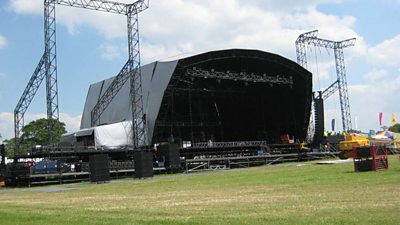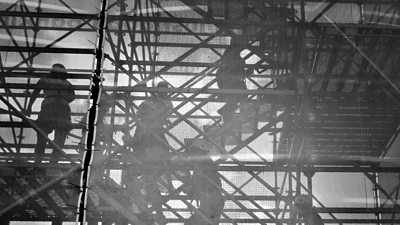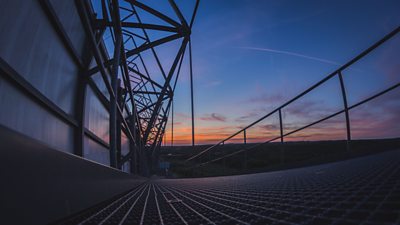This guide covers both temporary rostra and risers together with temporary staging primarily used for events; which requires a more rigorous design, inspection and certification regime.
What Can Go Wrong?
- If temporary staging, rostra and risers are not properly installed, staff and performers could trip, fall or otherwise injure themselves.
Legal/���˿��� Requirements
- Wherever possible a ���˿��� pre-vetted contractor should be engaged to build the temporary structure required. However, this may not be possible if the temporary structure has been provided by a promoter, for example. In this case, it is still a requirement to ensure that an adequate inspection has taken place and certification has been provided.
- The Construction (Design and Management) Regulations 2015 (CDM 2015) came into force on 6 April 2015, replacing CDM 2007 and are now applicable to the use of temporary staging, rostra and risers within the event industry.
Control Measures
General Controls
- At the initial planning stage discuss how the requirements of CDM 2015 will be discharged and who will undertake the roles of Principle Designer and Principal Contractor.
- All temporary staging, rostra and risers will be fitted or installed by competent persons only.
- All temporary staging will require a completion certificate to be provided by the installer. The installer will inspect the completed temporary staging and inform the performer’s manager or the senior producer that it has been inspected and is now safe to use and provide the certification.
- Re-certification will be required in any changes are made to the maximum loads expected/advised after initial build/installation.
- The installer will ensure that no gaps or uneven joints are present
- All rostra or risers will be inspected by the performer’s manager or the senior producer prior to use to satisfy themselves it is safe to use. Any problems found will be brought to the attention of the installer.
- Outdoor stages must have an adequate weather plan (especially wind monitoring) in place and a clear action plan detailing; what actions to be taken, when and by whom.
- Re-inspection of a structure may well be required if adverse weather conditions have prevailed – consult the installer on the requirements for this to be carried out.
The design and size of a stage must ensure the following:
- Where possible, the front edge of the stage should have edge protection installed, to prevent any person from falling, prior to rehearsals and the performance taking place.
- At least 1 meter of clear space between the front edge of the stage and the performers.
- That all the performers with their instruments plus any technical equipment can be accommodated with sufficient room to allow access and emergency egress from the stage.
- The stage design must take into account the maximum load of any suspended items; lighting, PA, etc.
- Any changes to the pre-advised maximum load of suspended items must be approved (and certified) by the stage provider prior to any lifting/suspension taking place.
- The stage staircase widths are suitable and sufficient to allow the performers safe access and emergency egress to and from the stage and will also be fitted with hand rails.
- All edges of raised areas and steps must be marked to show the performers where the edges are when viewed in subdued lighting.
- Temporary stages not bound by walls behind or to the sides, will be fitted with a sturdy hand rail which will also include mid rails, to prevent players falling off the edges.
- Sufficient gangway provision is to be allowed for so performers can access/egress from their stage areas safely.
- Where the rear and sides of the stage are open apart from the handrails, chairs must be positioned well away from the edges to prevent chair legs tipping over the edge, additionally wooden batten strips must be fixed along these edges.
- See also guidance below about Low Frequency Vibration, when applicable.
Accessibility
- If a disabled performer is required to access the stage then all necessary adjustments to the stage design must be made to accommodate their safe access and egress.
- A Personal Emergency Evacuation Plan (PEEP) must be drawn up for each disabled person accessing the venue and stage.
Dealing with Low Frequency Vibration
- Where percussion is present on a temporary stage consideration will be given to a separate structure specifically for them, to prevent unnecessary vibrations being transmitted through the staging to the other players. It is extremely important that the two stages are properly and suitably constructed to prevent any movement introducing gaps or uneven joints between them.
- On large temporary staging, acoustic or rubber matting should be fitted underneath percussion instruments e.g. drum kits or PA bass loudspeakers to prevent the low frequency vibrations being transmitted through the stage. All matting will be fixed along the edges with tape or something similar to prevent trip hazards.
Division Specific Issues
Radio & Music Events
- When a large temporary stage is in use, percussion instruments can create vibrations within the structure which can lead to nausea in some fellow performers on the stage.
- This is caused by the low frequency vibration.
FAQs/Did You Know?
- Several staging designs are produced in modular kit form for easy assembly. However, if any modifications or additional loadings are made to the structure then a competent designer/structural engineer should be consulted to confirm that the structural integrity of the design has not been/ will not be compromised.
Recommended links
-
-
Temporary demountable structures, guidance on procurement, design and use, fourth edition, 2017 (purchase required of full guide).
Related Topics
-

Temporary Stages and Rostra
This guide covers both temporary rostra and risers together with temporary staging. -

Seating Audiences Safely
How to seat our audiences safely at events and shows -

CDM Overview
Brief guidance on Construction Regulations -

Broadcast: Presentation and Linking Positions
Presentation or linking from purpose-built studio facilities. -

Working at Height: Scaffolding (tubular type)
Guidance on working on scaffolding -

Working at Height: Broadcast Gantries and High Level Platforms
Working on broadcast gantries and platforms
More from SSR
-
Your platform to record accidents, risk assessments, assurance monitoring and inspections
-
Safety Equipment Stores
Just one number to call: 020 3614 5155 -
���˿��� Safety Guidelines
An A-Z of ���˿���'s Health and Safety Guidelines -
Safety Advice Line: 0370 411 0464 Email: safety@bbc.co.uk
- A-Z of ���˿��� Safety Guidelines
- Accident Reporting and Investigation
- ���˿��� Health & Safety Policy
- Contractors (incl. vetted lists)
- Contributors
- Fire Safety
- Freelancers
- Independent Production Companies
- Risk Assessment
- Safety Alerts
- Safety Responsibilities
- Safety Training
- Sets & Premises Safety Guide
Events guidance - key links:
- Exhibitions
- General Guidance
- Indoor Location Recce Checklist
- Outdoor Location Recce Checklist
- Major Incidents & Emergency Planning
- Marketing and Promotional
- Noise Exposure
- Planning and Management
- Responsibilities
- Responsibilities Form
- Laser Lighting Effects
- Strobe Lighting
- Temporary Stages and Rostra
Health topics - key links:
- (���˿��� network only)
- Contributors Fitness to Participate
- Display Screen Equipment (DSE)
- (���˿��� network only)
- First Aid and Welfare on Location
- International Travel - Risks & Health
- Manual Handling
- Mental Health: ���˿���page
- (���˿��� network only)
- Personal Health and Wellbeing
- Pregnancy
- Psychological Trauma Support & Trauma Risk Management (TRiM)
- Tiredness and Fatigue
- Travel Health Contacts
���˿��� High Risk - key links:
- CBRN and Industrial Spills
- Covert Filming
- Crisis Management and Security Support
- Demonstrations, Protests and Crowds
- Disaster Coverage
- Door Stepping
- (���˿��� network only)
- (���˿��� network only)
- Public Order
- Safety Equipment Stores
���˿��� Journalism - key links:
���˿��� Productions - key links:
- Aerial Filming and Airfields
- Animals: Displaying and handling for performance
- Boats: Working on
- Children and Young People
- Driving
- Electrical Equipment and Systems
- First Aid and Welfare on Location
- Food Safety (Cooking and Catering)
- Remote Location Working
- Roads and Streets: Working by
- Security of Productions on Location
- Stunts
- Tiredness and Fatigue
- Unmanned Aerial Systems (UAS aka Drones)
- Vehicles: Recording in, from and around
- Working at Height: Mobile Elevating Work Platforms
- Working at Height: Tower Scaffolds
���˿��� Radio - key links:
- (���˿��� Network only)
���˿��� Security - key links:
���˿��� Sport - key links:
About this site
This site describes what the ���˿��� does in relation to managing its health, safety and security risks and is intended for those who work directly for the ���˿���.
It is not intended to provide instruction or guidance on how third parties should manage their risks. The ���˿��� cannot be held liable for how this information is interpreted or used by third parties, nor provide any assurance that adopting it would provide any measure of legal compliance. More information
Some links on this site are only accessible when connected to the ���˿��� network
